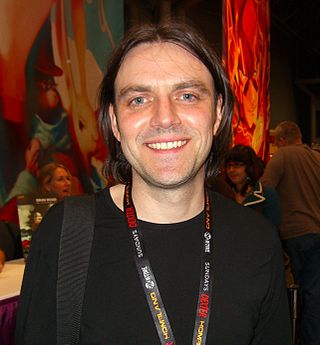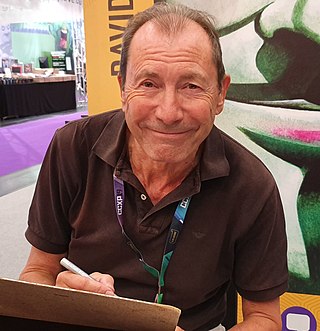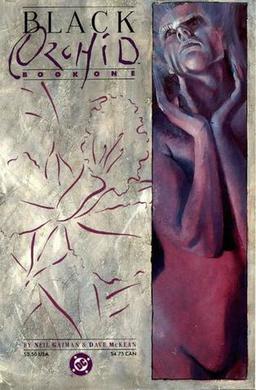History
Prior to the start of the British Invasion, DC Comics had imported several British artists from the early 1980s to work on their comic books. Brian Bolland was at the vanguard of this influx. Others that followed included Dave Gibbons, Brendan McCarthy, Glenn Fabry, Steve Dillon, and Philip Bond. [1]
The British Invasion itself is often cited as occurring in the wake of Alan Moore's successful run on Swamp Thing and his Watchmen series. [2] After Moore had a falling-out with DC and swore never to work for them again, DC editor (later Vertigo Group Editor) Karen Berger recruited many promising writers and artists from the UK. The names primarily associated with the invasion include Jamie Delano, who was approached by DC as the writer of the Swamp Thing spin off Hellblazer ; Neil Gaiman and Dave McKean, who collaborated on the Black Orchid limited series, as well as the famous and acclaimed Sandman ; Peter Milligan, who launched a new Shade, the Changing Man series; and Scottish creator Grant Morrison, whose pitch of an Animal Man series was approved. Later British creators to work on American comics include Mark Millar, Warren Ellis, Garth Ennis and Paul Jenkins.

Vertigo Comics was an imprint of American comic book publisher DC Comics started by editor Karen Berger in 1993. Vertigo's purpose was to publish comics with adult content, such as nudity, drug use, profanity, and graphic violence, that did not fit the restrictions of DC's main line, thus allowing more creative freedom. Its titles consisted of company-owned comics set in the DC Universe, such as The Sandman and Hellblazer, and creator-owned works, such as Preacher, Y: The Last Man and Fables.

John Constantine, Hellblazer is an American contemporary horror comic-book series published by DC Comics since January 1988, and subsequently by its Vertigo imprint since March 1993, when the imprint was introduced. Its central character is the streetwise English sorcerer and con man John Constantine, who was created by Alan Moore and Stephen R. Bissette, and first appeared as a supporting character in Swamp Thing #37, during that creative team's run on that title. Hellblazer had been published continuously since January 1988, and was Vertigo's longest-running title, the only remaining publication from the imprint's launch. In 2013, the series concluded with issue 300, and was replaced by Constantine, which returned the character to the mainstream DC Universe. The original series was revived in November 2019 for twelve issues as part of The Sandman Universe line of comics, under the DC Black Label brand. Well known for its extremely pessimistic tone and social/political commentary, the series has spawned a film adaptation, television show, novels, and multiple spin-offs and crossovers.

Grant Morrison MBE is a Scottish comic book writer, screenwriter, and producer. Their work is known for its nonlinear narratives, humanist philosophy and countercultural leanings. Morrison has written extensively for the American comic book publisher DC Comics, penning lengthy runs on Animal Man, Doom Patrol, JLA, Action Comics, and Green Lantern as well as the graphic novels Arkham Asylum, JLA: Earth 2, and Wonder Woman: Earth One, the meta-series Seven Soldiers and The Multiversity, the mini-series DC One Million and Final Crisis, both of which served as centrepieces for the eponymous company-wide crossover storylines, and the maxi-series All-Star Superman. Morrison's best known DC work is the seven-year Batman storyline which started in the Batman ongoing series and continued through Final Crisis, Batman and Robin, Batman: The Return of Bruce Wayne and two volumes of Batman Incorporated. They also co-created the DC character Damian Wayne.

Vincent Patrick Deighan, better known by the pen name Frank Quitely, is a Scottish comic book artist. He is best known for his frequent collaborations with Grant Morrison on titles such as New X-Men, We3, All-Star Superman, and Batman and Robin, as well as his work with Mark Millar on The Authority and Jupiter's Legacy.

John McCrea is a comic book artist best known for his collaborations with writer Garth Ennis.

David Lloyd is an English comics artist best known as the illustrator of the story V for Vendetta, written by Alan Moore, and the designer of its anarchist protagonist V and the modern Guy Fawkes/V mask, the latter going on to become a symbol of protest.

Jamie Delano is an English comic book writer. He was part of the first post-Alan Moore "British Invasion" of writers which started to feature in American comics in the 1980s. He is best known as the first writer of the comic book series Hellblazer, featuring John Constantine.

Glenn Fabry is a British comics artist known for his detailed, realistic work in both ink and painted colour.
Chris Weston is a British comics artist who has worked both in the US and UK comics industries.
John Thomas Totleben is an American illustrator working mostly in comic books.
Philip John Bond is a British comic book artist, who first came to prominence in the late 1980s on Deadline magazine, and later through a number of collaborations with British writers for the DC Comics imprint Vertigo.
The Eagle Awards were a series of British awards for comic book titles and creators. They were awarded by UK fans voting for work produced during the previous year. Named after the UK's seminal boys' comic Eagle, the awards were launched in 1977 for comics released in 1976.
Dean Ormston is a British born comic book artist. His most notable work has been for the British comic 2000 AD and for DC Comics' Vertigo imprint.
The National Comics Awards was a series of awards for comic book titles and creators given out on an annual basis from 1997 to 2003 for comics published in the United Kingdom the previous year. The votes were by the U.K. comics fan community, and were open to anyone.

John Higgins is an English comic book artist and writer. He did significant work for 2000 AD, and he has frequently worked with writer Alan Moore, most notably as colourist for Watchmen.
The character the Swamp Thing has appeared in seven American comic book series to date, including several specials, and has crossed over into other DC Comics titles. The series found immense popularity upon its 1970s debut and during the mid-late 1980s under Alan Moore, Stephen Bissette, and John Totleben. These eras were met with high critical praise and numerous awards. However, over the years, the Swamp Thing comics have suffered from low sales, which have resulted in numerous series cancellations and revivals.

Black Orchid is an American comic book written by Neil Gaiman with art by Dave McKean. It was published by DC Comics as a three-issue limited series from December 1988 to February 1989, and was later reprinted in trade paperback form. Black Orchid follows two girls, Flora and Suzy, who awaken in a greenhouse. Their journey to find out who they are leads them into contact with DC Universe figures like Batman and Swamp Thing, but also into conflict with criminal mastermind Lex Luthor, who seeks them for his own interests.
The UK Comic Art Award was a series of British awards for achievement in comic books. Winners were selected by an open vote among British comic book professionals ; the awards were given out on an annual basis from 1990 to 1997 for comics published in the United Kingdom the previous year. Award presentations were generally held at the Glasgow Comic Art Convention, usually in the spring.

Speakeasy was a British magazine of news and criticism pertaining to comic books, comic strips and graphic novels. It published many interviews with both British and American comics creators.










